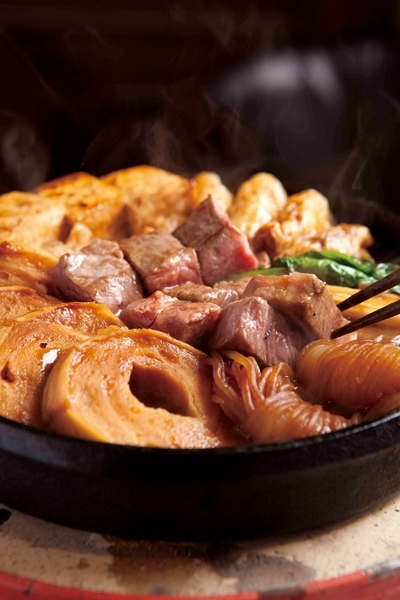YAKITETSU
Premium Japanese Hotplate Dining
名物・焼鉄
「牛鍋喰わずは開かぬ奴」 古来より文明開化の時代、それまで一般的には食べることのなかった牛肉が、 横浜・開港により食文化として持ち込まれました。 明治に入り屠畜場ができると爆発的に食牛の習慣が広まりました。
1868 年横浜に「太田なわのれん」が開店し、この店で 初めて味噌煮込み風の牛鍋が提供され牛鍋の原型となりました。 新しい者好きの江戸っ子気質から庶民にたいへん気に入られ、 当時、横浜から東京圏に数 100 店舗もの牛鍋屋があったとされています。 他にはない、「新物・名物」として 焼鉄がお召し上がりいただけます。
From ancient times to the rise of civilisation, it was not a common practice to consume beef. However, the culture of eating beef somehow managed to take root in Yokohama after the opening of ports.
The start of the Meiji period saw the building of many slaughterhouses as the culture of eating beef began to spread.
In 1868, a shop called “Ota Nawa Noren” opened in Yokohama and sold their first “Gyu Nabe” (beef pot dish), where beef was cooked in miso.
This dish became very popular among the common people and the elites of Edo (current day Tokyo). This led to hundreds of “Gyu Nabe” shops opening all the way from Yokohama to Tokyo.
Taking inspiration from “Botan Nabe” (wild boar pot), we refined the dish by adding sauce to the miso to make it easier to cook, and including leeks to remove the beef smell.
The pot used for this dish is made from thick cast iron, hence the name “Yakitetsu” (cooking on iron). The flat round shape of the pot ensures that heat is spread evenly throughout so that the sauce is well absorbed by all the ingredients.
As for the sauce, it is made from “Edo Ama Miso”, a miso well-liked for its sweetness.
The whole pot filled with beef, vegetables and tofu is slow cooked over a fire, becoming our signature Edo style Yakitetsu.
江戸甘味噌
「江戸っ子に愛された贅沢品」光沢のある茶褐で深く蒸した大豆の香味と麹の甘みが見事に調和し、
とろりとした独特な甘みを持った粋な味噌。 京都の白味噌と同等の甘さを持ち、且つ塩分は通常の味噌に比べて約半分。 最盛期(江戸~大正)には東京の需要の 60%を占める人気商品でした。
Edo Ama-Miso
Luxury item loved by Edokko
The fragrance from the deeply steamed glossy brown soybeans, blends harmoniously with the sweetness of rice malt, forming this Miso which has a unique sweetness.
This miso has the same sweetness as the Kyoto White Miso, but half the salt content of normal miso. During its peak (Edo to Taisho period), this was a popular item which accounted for 60% of Tokyo’s demand.
鉄鍋
「国の伝統的工芸品」第 1 号の指定を受けている南部鐵器を使用しております。
岩鋳は、1902(明治 35)年の創業以来、110 余年にわたり、 伝統の技を守り、南部鐵器を一貫生産するトップメーカーです。 ふっくらと優しく繊細な鋳肌、
使うほどに愛着のわく重厚な味わいがあります。 伝統に磨かれながらも、常に生活の中に溶け込み、 生活の中に生きてきた、南部鐵器の本物だけが持つ味わいとぬくもりをご堪能ください。
Original Hot Plate
Traditional Crafts of the Japan
Using Nanbu Tekki (南部鐵器) which has been assigned as Number 1.
Iwachu is the top manufacturer of Nanbu Tekki (南部鐵器) who keeps the traditional techniques in its integrated production method, for more than 110 years since its establishment in 1902.
Gentleness in this traditional steel plate.
The more you use it, the more you will fall in love it. Although this is a traditional and old craft, it is still being used in this modern times.
How to Eat Yakitetsu





